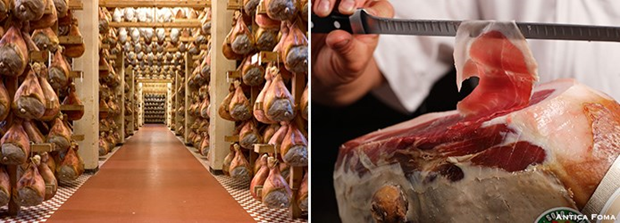A closer look at one of the most popular charcuterie specialities: raw ham. Why is it so delicious and irresistible? Science answers.
We
enjoy a number of delicious foods without knowing anything about the processes
involved in their making. A typical example is raw ham: despite being one of
the world’s most widespread and popular charcuterie specialities, few people
would be able to explain how it is actually produced.
Production method
It
must be said that the row ham method of production can vary a good deal from
one country to another, also owing to the characteristics of the meat, the
production plant and preservation facilities. One of the best methods is the
so-called “dry curing” technique used in Europe which gives us our prime
quality Italian and Iberian ham products.
It
all starts with the selection of pork meat which must comply with certain
characteristics in terms of origin, age and weight. Once slaughtered, the rear
haunches are taken and their temperature is reduced to 0°C in order to
facilitate the trimming process, which consists in carving the leg to give it
its typical rounded shape and removing any excess fat and part of the pork
rind.
The
next step is called salting and consists in covering the rind with wet salt and
the exposed meat with dry salt. The salted pork leg is then put back into a
refrigerated room for one week, after which it is removed, cleaned and salted
again. At this point, the leg is then put back into the refrigerated room for a
fortnight.

Raw ham: salting
Following
this phase, the ham is transferred to another refrigerated, humidity-controlled
room, where it is left to rest for at least eighty days. It is then washed in
water, dried and, as tradition demands, hung in well-aired drying rooms.
Throughout this process, the exposed meat has to be covered with pork fat and
spices to prevent it from drying excessively. After a period lasting at least
six months, the ham is then transferred to special cellars where it is cured,
according to the type of ham and its final market price.
Curing
From
a chemical point of view, this long painstaking process allows for what is
known as protein degradation. That is to say, the proteins “break up” into tiny
units called amino acids and form many of the aromatic substances giving ham
its special fragrance and flavour. This also occurs thanks to the phenomenon of
Strecker degradation, a chemical process which converts amino acids into
aldehydes.
This
series of reactions also comprises those of lipids, of which pork is
particularly rich: they too undergo a degradation which has an important impact
on the taste and aroma of ham because, after creating fatty acids, it converts
them into yet more aldehydes.

Raw ham: curing
You
will now realize that “simple” ham is fruit of a sum of chemical processes that
vary considerably according to the type of meat. For instance, we now know that
Iberian ham is rich in branched alkanes, substances which owe their presence to
the acorn diet of these pigs.
Some simple tips for
enjoying ham
This
is a food of multiple nuances that the chemical reactions of its natural
ingredients offer in abundance. For this reason, it is necessary to follow a
few simple rules if you wish to enjoy ham at its best.
First
of all, it should be accompanied with unsalted bread so as not to detract from
its intrinsic savoury flavour. Then there is the question of how to cut it:
manually or on a machine? Barring any theatrical impact involved, there are no
valid scientific grounds for preferring ham cut with a knife. More importantly,
machine cutting gives us even, very fine slices which, ideally, should never
exceed a thickness of two millim85etres.
A
final word: ham should never be served straight from the fridge but at room
temperature at which point its fats will have “melted” sufficiently.
By Riccardo
Meggiato/ FDL